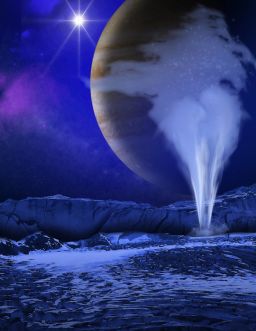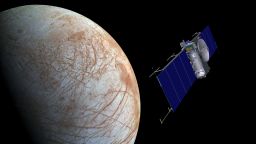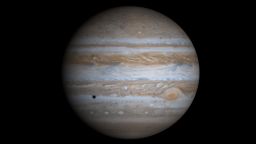Story highlights
Mission to Europa, one of Jupiter's moons, passes big hurdle
Icy moon may have ingredients for life
NASA has included $30 million in its 2016 budget to plan the mission
NASA wants to go to Europa. No, it’s not in Europe. And for soccer fans, it has nothing to do with the Europa League.
Europa is one of Jupiter’s larger moons. It’s about the size of Earth’s moon, and it’s thought to be one of the best places to look for life in our solar system – besides Earth, of course.

Interest in the icy world heated up in 2012 when the Hubble Space Telescope observed water vapor above the south polar region of Europa. NASA says those observations gave scientists strong evidence of water plumes erupting off the moon’s surface.
Long before Hubble made those findings, a NASA spacecraft named Galileo traveled to Jupiter in 1995 and found evidence that Europa has a salty ocean beneath its frozen crust. NASA says that ocean may have more than twice as much water as Earth.
“Europa has tantalized us with its enigmatic icy surface and evidence of a vast ocean, following the amazing data from 11 flybys of the Galileo spacecraft over a decade ago and recent Hubble observations suggesting plumes of water shooting out from the moon,” John Grunsfeld, associate administrator for NASA’s Science Mission Directorate in Washington, said in a statement in May.
“We’re excited about the potential of this new mission and these instruments to unravel the mysteries of Europa in our quest to find evidence of life beyond Earth.”

NASA hopes the new probe will help determine if Europa really does have the ingredients for life, according to Barry Goldstein, manager of the Europa Project at NASA’s Jet Propulsion Laboratory in Pasadena, California.
The mission took a big step forward Wednesday when NASA announced it had been moved to what’s called the “formulation phase,” Goldstein told CNN in an email.
“In this phase we mature the mission design and requirements to assure we are asking the correct science questions, and designing the correct mission to answer those questions,” he said.
The space agency has included $30 million in its 2016 budget to plan the mission. Goldstein said there’s still work to do before NASA officially clears mission managers to build the hardware and software for the mission.
If the mission does get final approval, the spacecraft would be launched in the 2020s. It would take several years to get to Jupiter, and when it arrived it would “orbit the giant planet about every two weeks, providing many opportunities for close flybys of Europa,” according to a NASA statement.
NASA says the mission plan includes 45 flybys at altitudes ranging from 16 miles to 1,700 miles (25 kilometers to 2,700 kilometers). With each pass, the spacecraft would collect information about Europa’s surface and use instruments to look deep inside the small world.
Nine science instruments have been selected so far, including cameras, ice penetrating radar and a magnetometer.
A bit more about Europa and Jupiter
Europa is one of the four largest moons orbiting Jupiter, the biggest planet in our solar system – so big that 1,000 Earths would fit inside. Italian astronomer Galileo Galilei is given credit for discovering Europa, Io, Ganymede and Callisto in 1610, and so the four are known as Galilean satellites or moons. German astronomer Simon Marius claimed to see the moons at about the same time, but Galileo published his findings first. Jupiter also has dozens of other smaller moons.
Jupiter is about 390 million miles (629 million kilometers) from Earth when the two planets are at their closest.
Despite the distance, you can see Jupiter with the naked eye on a clear night. In fact, Jupiter and the much brighter Venus are putting on quite a show in the evening sky this month. If you go out after sunset and look west, you can see the two planets fairly close together. They look like two bright lights. In late June and early July, the two planets will be at their closest until August 2016.
If you have binoculars or a telescope, you can see Jupiter’s largest moons, including Europa. They will look like tiny lights near Jupiter.
Jupiter’s other visitors

While the new probe will focus on Europa, Jupiter has had a steady stream of visitors from Earth over the past few decades:
• December 1973: NASA’s Pioneer 10 became the first spacecraft to fly by Jupiter.
• December 1974: Pioneer 11
• March 1979: Voyager 1
• July 1979: Voyager 2
• December 1989: Galileo (dropped a probe into Jupiter’s atmosphere).
• February 1992: Ulysses
• December 2000: Cassini-Huygens
• February 2007: New Horizons
Even if it gets approved quickly, the Europa spacecraft won’t be the next visitor to the Jupiter system. NASA’s Juno spacecraft is due to arrive at Jupiter on July 4, 2016.



















